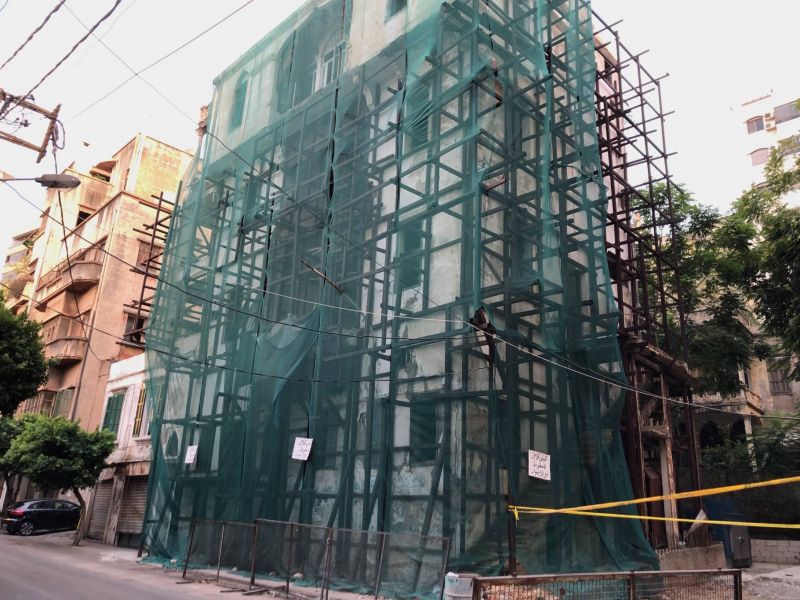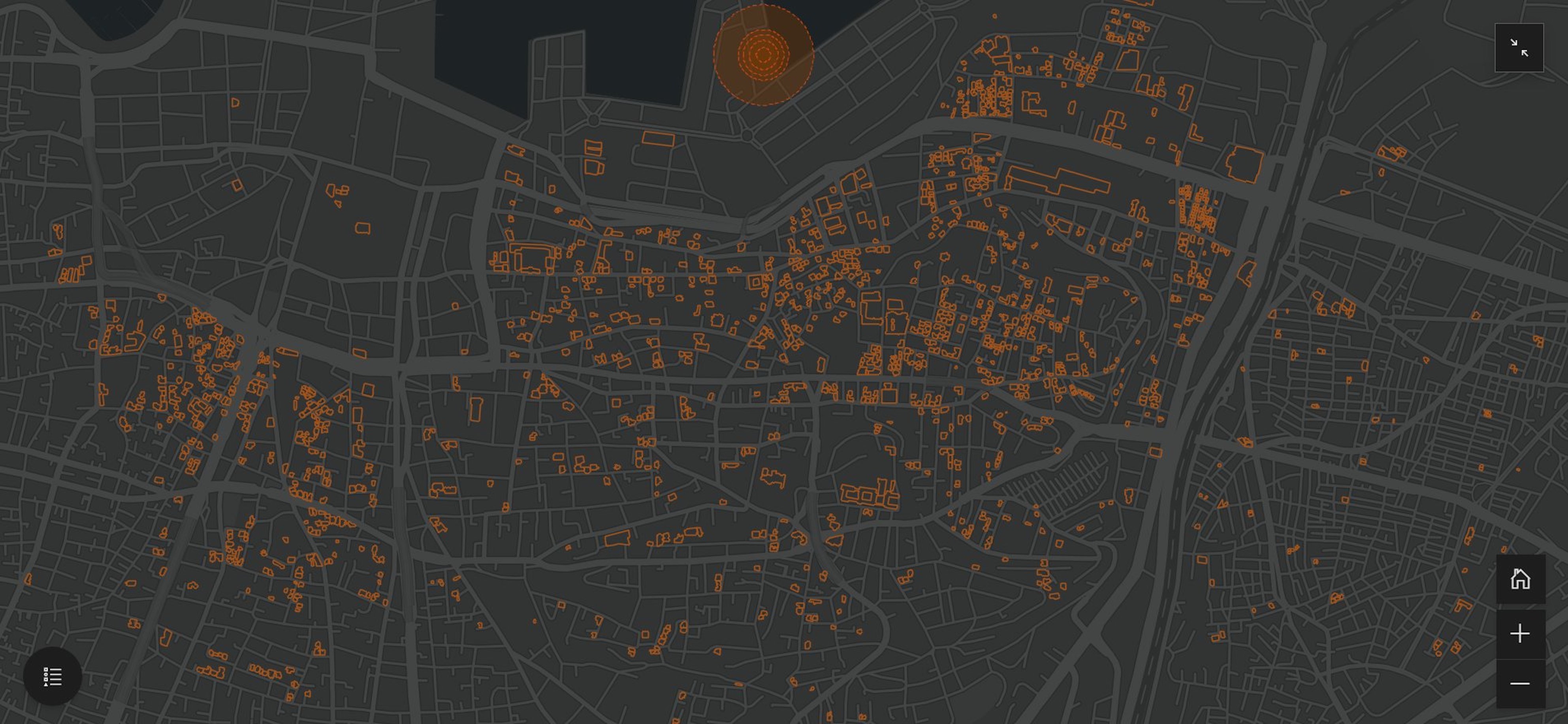
Temporary scaffolding used to keep building erect in Beirut. (Credit: Moe Chamaa)
BEIRUT — Almost a month after the catastrophic earthquake that hit Turkey and Syria, the death toll rises, and questions persist concerning how better building practices would have saved more lives. Like the aftershocks felt from seismic activity on the Syria-Turkey border, these questions resonate in Lebanon, where structural safety concerns remain unanswered.
In the wake of scenes of corpses being pulled from entire blocks flattened in the Feb 6 quake, the enforcement of Turkey’s building codes have been called into question, with some people pointing fingers at developers who misled the public on this issue.
Similar concerns have been raised in Lebanon about the structural integrity of many of the country’s buildings, with many complaints emerging of cracks in the walls and partial collapses.
“I know that all the buildings that were constructed in Beirut, in the 1960s-70s-80s and 90s are subject to damage,” explains Bilal Hamad, former mayor of Beirut and a professor of civil engineering at the American University of Beirut. He says a magnitude-six earthquake lasting 20-30 seconds would cause “a disaster not only in Beirut but all over Lebanon.”
Though there are laws that regulate earthquake safety dating from 2005, these do not account for buildings erected before then.
Safety regulations, in theory
In Lebanon, the 2005 building law and its 2012 amendments regulate building safety for all contingencies — earthquakes included.
Contrary to popular belief, when it comes to withstanding earthquakes, Hamad says that engineers and architects don’t take into account Richter scale (a measure of amplitude or largest tremor), rather they focus on peak ground acceleration, which measures how much the earth shakes during an earthquake.
He says that buildings need to be “[pliable] enough to ride out the event” with as little damage as possible. This means that the structure is able to undergo deformation without collapsing; structures made of brittle material would collapse more quickly during an earthquake.
According to Hamad, the 2012 law set the benchmark at 0.25 G, meaning 25 percent of the peak ground acceleration. Typical earthquake accelerations are between 0.05 and 1 g. 0.005 G would barely be felt (and then not by many). Shaking over 0.05 G is unpleasant and few structures would survive an acceleration of more than 0.5 G. In short, the Lebanese benchmark should protect structures built since 2005 from an earthquake of 6 on the Richter scale.
Hamad argues that, given Lebanon’s history of earthquakes — the most significant in recent history being those dating to 1918, 1956 and 1997 — buildings “should be designed for 0.3 G, or seismic zone 3, according to the United States UFC code.” This, he believes, should suffice for earthquakes of magnitude seven and above on the Richter scale “with minor damage, non-structural damage.”
A 2011 study, written by Carla Huijer, Mohammed Harajli, Saleh Sadek, from the AUB’s Civil Engineering department, and published in the Lebanese Science Journal, recommends buildings be designed for 0.25 G. It also advises that in coastal areas such as Saida, Beirut and Tripoli — “where most of Lebanon’s population and capital investments are located” — and for the area around the central part of the Yammouneh fault, the benchmark be raised to 0.3 G.
To enforce the 2012 modifications to the building law, and to the Order of Engineers and Architects (OEA) ensure that safety procedures were being adhered to, developers are required to hire technical control officers to check safety measures in the design and construction of buildings and report their findings to the OEA.
Law vs. practice
In practice, as usual, the laws are not often enforced.
Soha Mneimneh, a member of the OEA representative council, the order’s legislative assembly, noted that despite the laws in place, a lack of monitoring and evaluation remains a huge issue. She says that while conducting research with real estate developers, she noted that many of them were not enthusiastic about the 2005 building law.
“Usually real estate developers prefer not to implement this law because it costs them more,” she tells L’Orient Today.
For instance, the law specified that space is given for orderly evacuation of the buildings, but developers complain that this detracts from how much space they can devote to residential units, meaning less profit per square foot.
“This space should be taken out from the total built-up area, and this would decrease the number of units they can build,” Mniemneh says.
“They ignore all those laws and there’s no monitoring to even check on them. So people need to know that we lack monitoring throughout construction,” she adds. “The municipality only checks for safety in the beginning but not for the rest of the process.”
Technically, developers need to submit their initial designs to the technical control officer, who then approves it or makes alterations in order to clear it. After that, a schematic design is produced, followed by an execution design, which all needs to be checked by the officer and approved.
From there the plan can be submitted to the OEA, then the municipality to receive a building permit. As Hamad summarizes the process, there needs to be “a file signed by the technical control office that the design was checked and approved and that it can resist earthquakes. So after 2005, supposedly, all buildings that were constructed can resist earthquakes.”
In reality, however, this is not always the case.
Can we earthquake-proof older buildings?
In Lebanon, as in Turkey and Syria, it’s not only a matter of following safety codes, but also earthquake-proofing structures built before 2005.
“Old buildings in Beirut will be all destroyed if we have an earthquake above six” on the Richter scale, says Hamad. He argues that they lack the ductility needed to withstand a quake. “Until now, we have these cultural [heritage] buildings that are not even prepared to carry their own load.”
Mneimneh notes that many heritage buildings that are built from sandstone have shallow foundations or none at all, and are unable to withstand large earthquakes compared to buildings made of concrete and have deeper foundations. But, she adds, “this doesn’t mean that the latter is able to withstand earthquakes without damage.”
A 2017 study presented at the 16th World Conference on Earthquake Engineering based on buildings surveys in Koura, North Lebanon found that, in a Lebanese context, old masonry buildings were more susceptible to damage than concrete structures in a potential earthquake. The study recommended “to reinforce the masonry buildings and to add some shear walls to the concrete frame buildings.”
Hamad himself has worked on many projects to make rehabilitated buildings earthquake resistant, among them the Justice Palace in Beirut’s Adlieh neighborhood. The original structure’s foundation did not reach bedrock; Hamad’s team reinforced it using micropiles, a type of underground column affixed on top of a footing in the soil.
Such an undertaking is expensive, he says, but not impossible.
He notes that other cities that are prone to earthquakes face the same problem, especially on the West Coast of the United States, where he used to live. Nonetheless, before 2000 they made the investments to retroactively quake-proof their buildings, using shear walls that are made of reinforced concrete.
Architect Brad Barndt, of BHB Designs, has worked on retrofitting buildings against earthquakes in Seattle, Washington. He says buildings can be reinforced using retrofitting techniques — additional steel structures including cross-bracing and ties, which secure brick and stone facades in older buildings — in order to reduce an earthquake’s impact.
“You see these features throughout Seattle. Often in large buildings, these elements are very noticeable, yet the skilled designer is able to make them an attractive part of the building’s architecture.”
Although some people can upgrade out of pocket, he noted that for a large-scale project such as this, there needs to be government and community involvement to ensure the work is effectively done. “After all, the health and safety of the people come first. It’s not a matter of ‘IF’ an earthquake occurs. It’s ‘WHEN’ will it occur? It WILL happen in Lebanon.”
 The locations of buildings structurally compromised as a result of the Aug 4, 2020, port blast. (Credit: Beirut Urban Lab)
The locations of buildings structurally compromised as a result of the Aug 4, 2020, port blast. (Credit: Beirut Urban Lab)
Missed Opportunities and lack of coordination
According to a survey conducted by the Lebanese Army, there are 16,000 structures across the country that were in dilapidated condition before the earthquake. According to a Beirut Urban Lab survey, 1,500 buildings damaged in the Beirut port blast, some have been repaired.
Hamad says that, during his time as mayor, he commissioned a report funded by the World Bank on the structural soundness of buildings in Beirut, categorizing them by age and condition. He says the idea came after a building collapsed in Achrafieh in 2011. “We asked the World Bank to help us do a master plan for the city of Beirut to make it resistant to earthquakes and other natural hazards.”
The agency gave the municipality one million dollars, and using that money, they contracted the British firm Buro Happold, who produced a master plan that identified buildings most prone to risk and that need to be upgraded. The plan also highlighted the means needed to create social awareness around this topic, as well as “how to create in the municipality a unit or department which would manage a disaster.”
Work on the plan commenced while Hamad was still in office and was completed in 2017 after his term had ended. He says nothing was done with this plan: “It seems that the study was put in some drawer. I don’t know which drawer, and nothing was implemented.”
He says this was a missed opportunity, given that at the time the Beirut municipality had $600 million in its coffers, which it could have used to do something about the most vulnerable buildings. “Let’s start with these buildings, these are priorities. Let’s upgrade them… The dollar was LL1,500, we had $600 million in the municipality of Beirut… Now, this is worth $10 million because our money is in Lebanese pounds.”
Both the current Beirut Mayor and Governor did not respond to requests for comment from L’Orient Today.
Even when it is known where the problem sites are, issues with methodology and which methods to apply arise. Hayes Buchanan, a research coordinator at Beirut Urban Lab’s observatory, told L’Orient Today that different institutions collected damage data after the blast using different methodologies.
Buchanan noted that when these data sets are compared, “we find that in some cases they disagree about the classification of structural or nonstructural damage, which is troubling. The reason why it’s so troubling is that it limits what is known about the conditions of the built environment in the blast zone.”
So far, Lebanon has yet to see the caretaker government present a comprehensive plan of action in response to the earthquake. Such a move is in keeping with the Lebanese state’s consistent inaction in pressing issues such as affordable housing.
For Mneimneh housing and safety are two sides of the same coin. “When we talk about the right to housing, it’s not just the right to access housing,” she says. “People also have a right to adequate and safe shelter.”